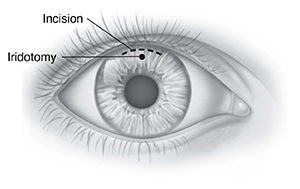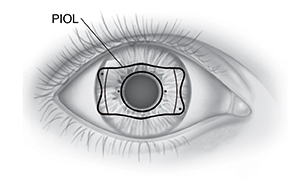Refractive Surgery: Phakic IOLs
Phakic intraocular lenses (PIOLs) are artificial lenses that are placed inside the eye. They help change the eye’s focusing ability to help you see better without glasses or corrective lenses. Some types of PIOLs are designed to go in front of the iris. Other types go behind the iris. The natural lens is not removed. This procedure may be combined with excimer laser surgery to reshape the cornea. PIOLs are approved in the U.S. to treat nearsightedness.
What to expect during your procedure
-
Before treatment, you'll be given local anesthesia. You may also be given medicine to help you relax.
-
A drainage hole (peripheral iridotomy) may be made in the iris to prevent fluid buildup.
-
A cut (incision) is then made at the edge of the cornea. The lens is inserted through the incision either in front of or behind the iris.
-
After the procedure, your eye may be bandaged. Your vision should start to improve the next day. It should become stable in 1 to 3 weeks.

 |
| PIOLs are made of a safe plastic material. |
Pros of PIOLs
-
They can be removed or replaced if they don't work out well.
-
They can correct some extreme refractive problems.
-
They still allow your eye's lens to change shape to focus light (accommodation), since your natural lens remains in place.
-
They don't cause thinning of your cornea.
-
They have a reduced risk of causing vision problems such as halos, glare, or starbursts.
Cons of PIOLs
-
Long-term effects are still unknown
-
May increase your risk of getting cataracts
-
May cause serious vision problems if there is infection or redness and swelling (inflammation)
-
Risk of losing your vision
-
Risk of undercorrecting or overcorrecting your vision
-
Risk of losing your best-corrected vision
-
Risk of having a detached retina
Online Medical Reviewer:
Janet Campbell RN BSN
Online Medical Reviewer:
Whitney Seltman MD
Date Last Reviewed:
9/1/2025
© 2000-2025 The StayWell Company, LLC. All rights reserved. This information is not intended as a substitute for professional medical care. Always follow your healthcare professional's instructions.